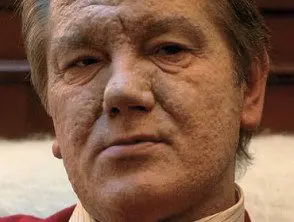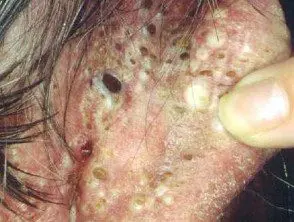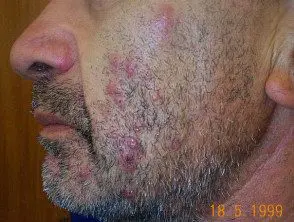What is chloracne?
Chloracne is a rare skin condition caused by certain toxic halogenated aromatic hydrocarbon chemicals, including dioxins. It develops a few months after swallowing, inhaling, or touching the responsible agent.
The name "chloracne" is misleading, because it is not related to acne. A more correct terminology is "MADISH": skin induced by dioxin-induced metabolization Hamartomas. Instead of hyperactive sebaceous glands, as in acne, the glands concentrate the responsible chemical and metabolize it extremely slowly. This process alters gene expression in the sebaceous glands and transforms them from functioning fat producing glands to chloracne skin cysts (hamartomas).
Most cases of chloracne are due to occupational exposure, but chloracne can also arise after accidental environmental poisoning. One hundred and ninety-three cases of chloracne were the result of an industrial accident in Seveso, Italy, in 1976. Deliberate dioxin poisoning is attributed to the changed appearance of Ukrainian President Victor Yushchenko in September 2004. Dioxin and dioxin aromatic hydrocarbons Very low levels are ubiquitous in the environment, but standard environmental exposure does not produce chloracne.
Chloracne

President Victor Yushchenko, December 2004 © TIME South Pacific, with permission
What causes chloracne?
Chloracne is caused by exposure to halogenated aromatic hydrocarbons, which are most often found in:
- Fungicides
- Insecticides
- Herbicides
- Wood preservatives
Chloracne is the most common skin. sign of dioxin poisoning. The responsible chemicals include:
- Chlornaphthalene
- Polychlorinated biphenyls (PCBc)
- Polychlorinated dibenzo-p-dioxins (PCDD)
- Polychlorinated Dibenzofurone (PCDF)
- Chlorophenol contaminants
- Trifluoromethyl
- Pyrazole derivatives
- Chlorobenzene
Acute poisoning
Acute exposure to extremely high levels of the above responsible chemicals can cause systemic Symptoms These include:
- Sudden and early gastrointestinal illness.
- Pancreatitis
- Liver dysfunction
- Neuropathy
As these systemic symptoms subside, changes in the skin begin, and this is when the diagnosis of chloracne may become more obvious. Skin changes are believed to occur when the chemical begins to redistribute itself from other organ systems to the sebaceous (fat) glands.
What are the characteristics of chloracne?
The characteristics of the chloracne are:
- Open and close comedones (pimples and blackheads)
- Not inflamed nodules and cysts
Lesions are most often seen on the cheeks, behind the ears, in the armpits, and in the groin. Although they resemble acne, the skin is not usually oily; In fact, the sebaceous glands are often smaller than usual.
Other skin problems seen in patients with chloracne include:
- Sweaty palms and plants (hyperhidrosis)
- Cutaneous porphyria delays (pigmentation, increased hair growth and blisters on exposed skin)

Pimples and cysts

Inflammatory lesions

Chloracne pimples
Other health problems
Other health problems may include:
- Abnormal liver function
- Tiredness (sleep disorders)
- Nervous conditions (transient peripheral neuropathy and encephalopathy: this can lead to poor concentration and depression)
- High levels of circulating blood fats (hyperlipidemia)
- Impotence
- Type 2 diabetes
Data for an association with other health problems and birth defects are conflicting.
How is a diagnosis of chloracne made?
Blood test levels of halogenated aromatic hydrocarbons are unreliable for diagnosis, due to the redistribution of chemicals around the body and its metabolism.
Diagnosis is based primarily on history and expert clinical opinion. Biopsies of the affected skin may show a reduction in the normal density of the sebaceous glands and the development of hamartomas of the skin. Immunohistochemical tests (eg, CYP1A1) can be performed on hamartomas to determine the up or down regulation of gene expression to support clinical diagnosis.
What is the treatment for chloracne?
Once chloracne has been recognized, the source of exposure should be identified and the affected person and other workers should be removed from the exposure.
Occupational disease due to exposure to chemicals is a mandatory notification condition. If you live in New Zealand, contact Worksafe NZ of the New Zealand Department of Labor for more information.
Most chloracne injuries heal within 2 years, and exposure to the chemical stops. In some cases, they persist much longer because the chemical continues to be slowly released from fat cells.
Persistent acne treatments can help persistent cases, particularly oral antibiotics and sometimes isotretinoin. Comedones and cysts can be pierced or seared.
